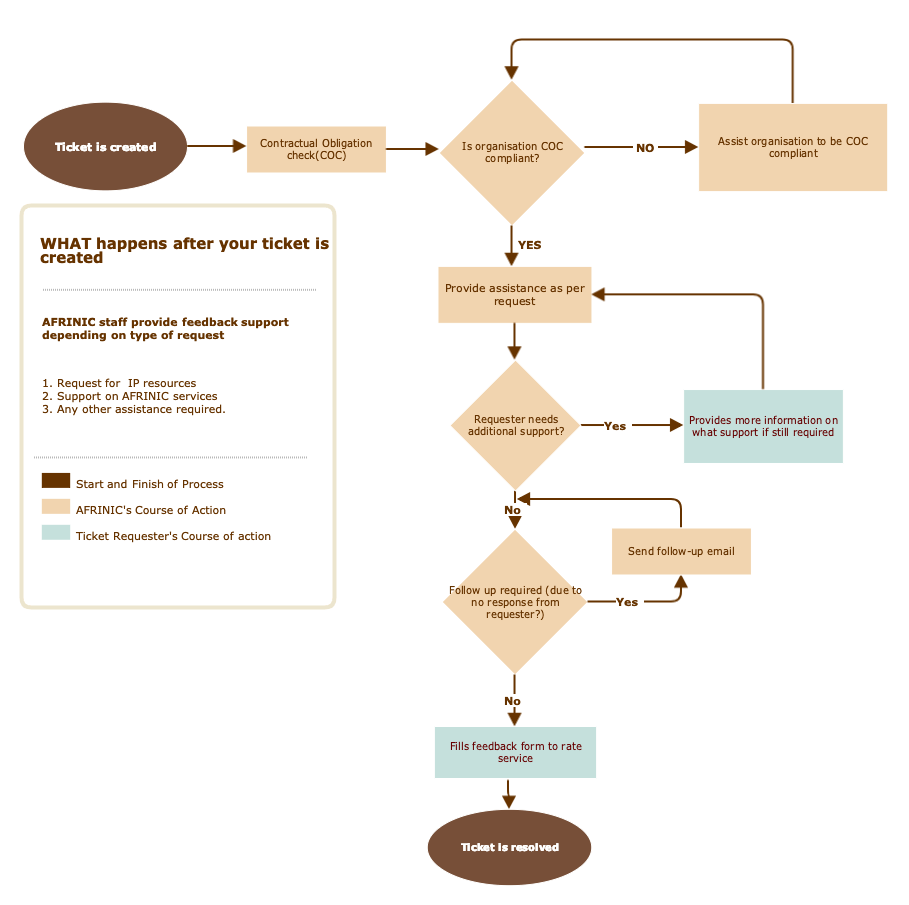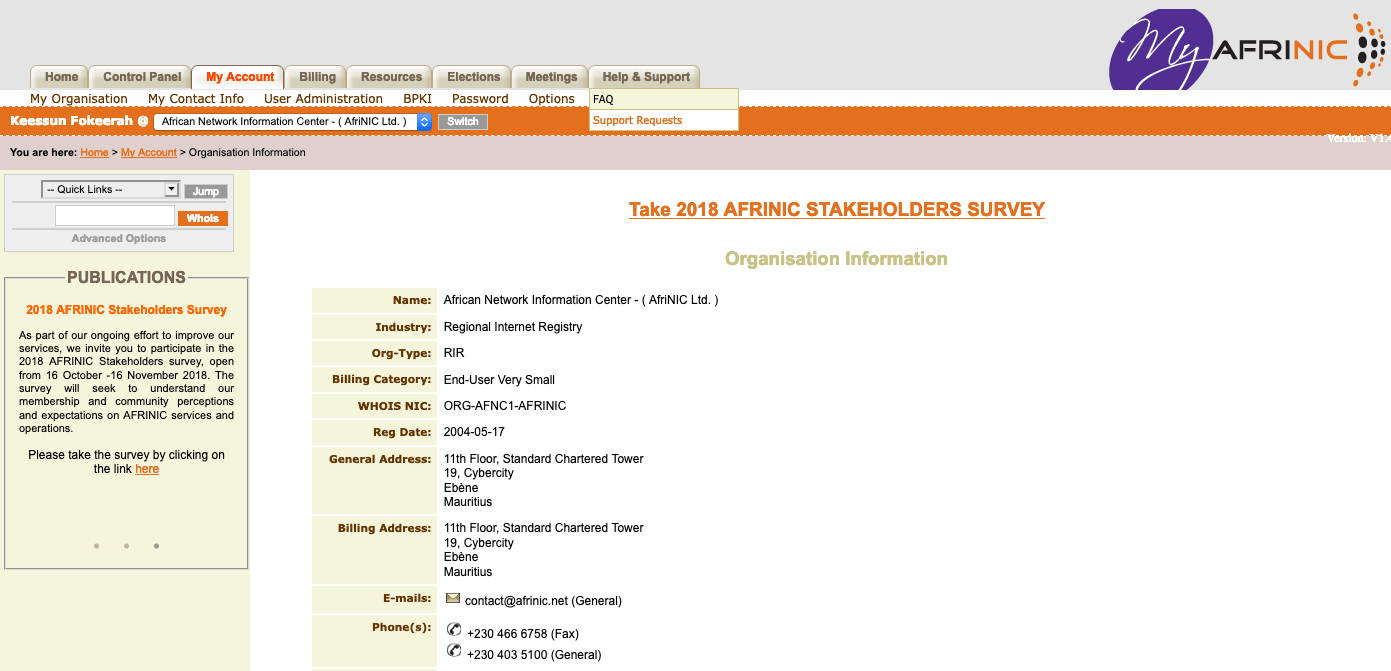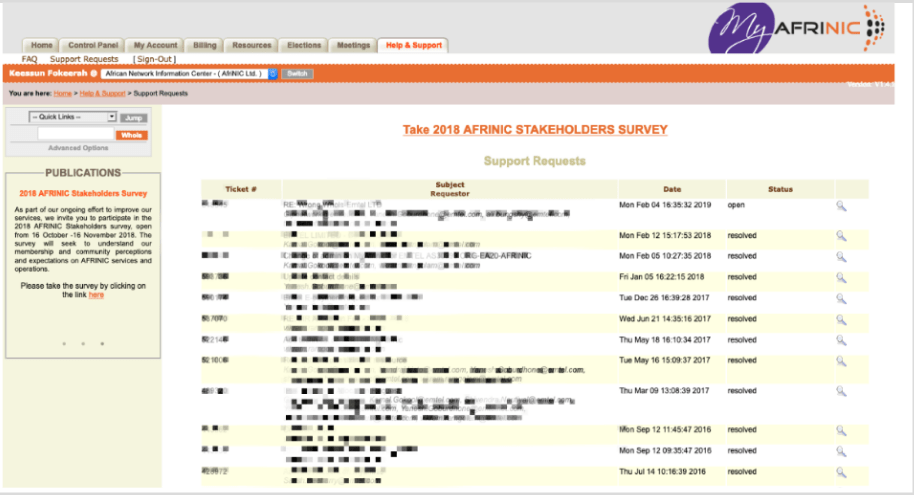How can we help you?

General Queries

AFRINIC recommends contacting the last network your traffic can reach; could be your upstream/IP transit provider or other networks within your traffic path. They should be able to advise the potential cause of your issue. We further advise on adopting the routing security services we provide, such as RPKI, Internet Routing Registry (IRR), Reverse DNS.
Abusive behaviour regarding whois queries will automatically be blocked. The process is detailed in Section1.7 of the database reference manual.
Complete the form by filling all the required details. The hostmaster will approve the request only if the requester has provided all the necessary information required for Bulk WHOIS. The completed form should be either fax to AFRINIC Ltd on +230 466 6758 or sent via email to This email address is being protected from spambots. You need JavaScript enabled to view it.. As soon as the request is approved the hostmaster will send you the link to access the Bulk WHOIS along with the user name and password.
The Bulk WHOIS request form can be downloaded from here.
You can access the AFRINIC Bulk Whois Data by filling out this form. It is important to ensure that your use remains compliant with the terms of use outlined in this application form and the AFRINIC Privacy policy.
AFRINIC does not provide domain name registration services. You may consult your ISP or any authorised domain name registrars, and they will help with your needs. For more information about TLDs (Top Level Domains) and ccTLDs (Country Code Top Level Domain) registrations, please visit ICANN website
1. What is an IP addressing plan?
An IP addressing plan is a document usually developed by network/design engineers to show how the IP addresses will be distributed among the network devices based on the network architecture or topology in a way that support the required services.
2. What are the benefits?
The IP addressing plan:
- will determine the number of IP addresses required immediately and in the long term to deliver the specified services to your customers.
- will also be used by your network engineers to maintain reachability between the different network segments.
- will ease future network expansion and modification.
3. Does AFRINIC still have IPv4 resources?
Yes, AFRINIC still has a pool of public IPv4 addresses from which it issues to its members based on justified need. For more information, please consult the IPv4 Exhaustion Stats page.
4 How to develop one?
4.1 Things that you should know:
Public IP address: an IP address that is a globally unique routable IP address and usually used to connect to or provide service over Internet.
Private IP address: Specific ranges reserved for private internets and usually used for corporate internal network . These ranges of IP addresses must be converted to public IP addresses through mechanisms like Network Address Translation (NAT) before the users can connect to the Internet (RFC1918, RFC4193)
Classless Inter-Domain Routing “CIDR” : A format used to describe IP address. It constitutes of two parts network part and the host part; for example 172.16.16.0/24. The CIDR notation specifies the IP address(172.16.16.0) and the associated routing prefix(/24).
How to calculate the routing prefix in CIDR notation:
Hosts bits >= log2 (no. of required IPs) [Approximate the next integer]
Network bits = 32 – hosts bits
Prefix size = /”Network bits”
Example: A network constitutes of 12 servers, 100 users in separate VLANs. The IT engineer wants to distribute the prefix 172.16.16.0/24 between the two VLANs. What is the network that will be given to each VLAN?
- Determine the prefix size for each VLAN:
- Servers VLAN:
hosts bits >= log2 12
>= 3.584
≈ 4
hosts bits = 4
network bits = 32 – 4 = 28
prefix size = /28
-
- Users VLAN:
hosts bits >= log2 100
>= 6.644
≈ 7
hosts bits = 7
network bits = 32 – 7 = 25
prefix size = /25
The networks will be: 172.16.16.0/28 for servers VLAN and 172.16.16.128/25 for users VLAN.
4.2 Information you should have:
- List of the intended services.
- Number of devices on your network.
- Number of Network/site (local or distributed/remote).
- Statistics about users on the network (concurrent users).
- Any available network topology diagram or architecture.
- Any expected service growth/development plans.
4.3 Important Notes:
Some of the sections below will refer to private IP addresses. Should these private IP addresses being NATed at your network, you must adjust the public IP addresses needs to cater for that. In fact, the private IP addresses have been mentioned in this document only because they are currently a network reality. It is believed that by eliminating NAT and moving towards IPv6, quality of services will enhance dramatically.
NAT aka Network Address Translation is one of the mechanisms used by network operators to compensate for the scarcity of IPv4 resources. In AFRINIC we discourage usage of NAT because it complicates the services provision, break the end-to-end communication model and hinder services evolution. We always encourage our members to get rid of NAT.
4.4 Getting to the real work:
Use the questions below to fill in the table in each section where applicable as per network site.
1. You need to determine the requirements for your core network:
- How many network nodes do you have?
- Will the nodes be using public or private IP addresses?
- Are your nodes connected using layer-2 device or layer-3 device or mix? If mix then determine number of nodes that will use layer-2 device and the ones that will use layer-3 device. If the nodes are connected directly to each other then consider it Layer-3 mode and calculate the number of connections instead of number of nodes.
- Determine the IP addresses required per node depending on the connection mechanism. If it is L-2 then each network device will need “1” IP address. If it is L-3 then each network device will need “4” IP addresses.
- If additional IP addresses is required for management then identify them.
- The management IP addresses for network devices are usually public IP addresses that might or might not be reachable through the Internet. Add them to the public IP addresses per node.
- Calculate the figures as follows:
- Public IP addresses = no. of network nodes x public IP addresses per node
- Private IP addresses = no. of network nodes x private IP addresses per node
| Network nodes based on connection type | Layer-3 connection | Layer-2 connection |
| No. of nodes | ||
| No. private IP addresses per node | ||
| No. public IP addresses per node | ||
| Total private IP addresses | ||
| Private IP addresses in CIDR | ||
| Total public IP addresses | ||
| Public IP addresses in CIDR |
2. You need to determine the requirements for your connections with the upstreams:
-
How many WAN connections do you have?
-
How many IP addresses are needed per WAN?
-
Usually WAN IP addresses will be supplied by your provider, is this your case?
-
Calculate the figures as follows:
In case WAN IP addresses are not given by your provider then:
Public IPs = no. of WAN connections x IPs per WAN
No. of WAN connections IP addresses per WAN Total Public IP addresses Public IP addresses in CIDR
3. You need to determine the requirements for each service that will be provided:
- How many servers per service?
- How many IP addresses are needed per server (If you are using virtual servers, please include their requirements)?
- Will the service be accessible from the Internet or will be restricted to your internal network? If yes, how many public IP is required per the server?
- Calculate the figures as follows:
- Total Private IP addresses = No. of servers * No. of IP addresses per server
- Total Public IP addresses = No. of servers * No. of public IP addresses per server
| Service List | Service “1” | ….... | Service “n” |
| No. of servers | |||
| No. of IP addresses per server | |||
| Total private IP addresses | |||
| Private IP addresses in CIDR | |||
| Is it accessible from Internet | |||
| No. of public IP addresses per server | |||
| Total public IP addresses | |||
| Public IP addresses in CIDR |
4. You need to determine the requirements for your end users (if applicable):
Classify your end users based on the provided services. If the end-user has more than one type of service then count it for each service separately. For each end-user category, answer the following questions.
- How many IP addresses are required per end-user per category? If it is variable, what is the average number?
- Is the service require use of public IP addresses? If yes, how many public IP addresses is required per end-user per category? Else set the public IP addresses number to zero.
- How many end users per category ?
- Calculate as follows:
- Total private IP addresses = IP addresses per end user x No. of end users
- Total public IP addresses = public IP addresses per end user x No. of end users
| Category List | Category”1” | …..... | Category “n” |
| No. of IP addresses per end user | |||
| No. of end uses per category | |||
| No. of public IP addresses per end user | |||
| Total private IP addresses | |||
| Private IP addresses in CIDR | |||
| Total public IP addresses | |||
| Public IP addresses in CIDR |
5. Go through your network, Is there any IP addresses requirements that doesn't fit in the previous mentioned groups? If yes then list them as follow:
- No. of IP addresses required.
- What is the type of required IP addresses? public or private?
- Detailed description of the intended usage of these IP addresses.
- Network diagram showing how they will fit with the other parts of your network.
6. Now that you have gathered the information, sum the total for each table and fill in the tables below:
- The Private IP addresses requirements:
| Network Segment | Site “A” | ….... | Site “N” |
| Core Network | |||
| WAN connections | |||
| Services | |||
| Customers | |||
| Additional requirements | |||
| Total required IP addresses | |||
| Total IP addresses in CIDR |
- The Public IP addresses requirements:
| Network Segment | Site “A” | ….... | Site “N” |
| Core Network | |||
| WAN connections | |||
| Services | |||
| Customers | |||
| Additional requirements | |||
| Total required IP addresses | |||
| Total IP addresses in CIDR |
To comply with AFRINIC policies, you will be required to provide your IP addressing plan for both immediate and future need. The future period is specified in the current IP resources management policies. You can read more about these policies at www.afrinic.net.
For any future plan repeat the same procedure taking into consideration the expected growth in each segment. You should be able to generate the same table to manifest your future requirements. The recommended format is to produce plans that shows immediate (0-3 months), medium term (6 months) and future (12 months). Such plans are more accurate and give better granularity which will be helpful in networks management and provision plans.
5 Practical example:
Company X is a service provider. It provides services like VPN, ADSL, Mobile broadband and dedicated Internet. The company has a customer base of 30,000 ADSL users, 500,000 mobile users and 1000 corporate users that use VPN. The VPN used private IP addresses only with average of 14 IP per user. At max 30% of the corporate customers have dedicated Internet in addition to VPN service, the average IP addresses assigned is 8. Some of the corporate customers prefer to use the uncommitted Internet services like ADSL and MB. Statistics during the peak hour showed that number of concurrent connected users during peak hours is 15,000 in the BRAS and 350,000 in the GGSN.
The recent market research conducted by company X marketing department shows the following:
- ADSL users are expected to grow in rate of 10% per year for the next 3 years.
- MB users will grow by 10%, 12%, 9% for the next three years respectively.
- Dedicated Internet users will decrease by 2% next year but grow at rate 5% per year after that.
- VPN users will increase at rate 7 - 8% for the coming three years.
The network diagram below shows company X network. They have 3 main sites A, B and C. Each site contains two core routers and one router that serve as distribution layer. Each site contains one BRAS, one GGSN and corporate connections. Moreover, site C is connected to the company corporate network where the publicly accessible mail and web servers are hosted in addition to some internal services. DNS, Mail and website services are available in the Internet. The company use active-standby protection for each service. In addition, DNS service is constituted of 4 different servers.
The company currently using IP addresses from its upstream and implement techniques like PAT and NAT to be able to provide services. As part of a new business continuity strategy, they decided to request IP addresses from AFRINIC. They have been requested to submit IP addressing plan.

Solution:
Following the procedure above, please find the below solution.
- Core Network:
There are 3 sites. Each site contains 3 routers, GGSN and BRAS which totals to 5 network nodes. They are connected using layer-3 and managed through private IP addresses. The 3 sites are symmetric, table below shows the requirements per one site.
Network nodes based on connection type Layer-3 connection Layer-2 connection No. of nodes 5 N/A No. private IP addresses per node 0 N/A No. public IP addresses per node 4 N/A Total private IP addresses 0 N/A Private IP addresses in CIDR 0 N/A Total public IP addresses 20 N/A Public IP addresses in CIDR /27 N/A
- WAN connections:
The connections between the 3 sites are considered as WAN connections and will be use IP addresses from the requested prefix.
No. of WAN connections 3 IP addresses per WAN 4 Total Public IP addresses 20 Public IP addresses in CIDR /27
- Services:
Since active-standby mechanism is used, each server is actually two physical servers. Assuming VRRP is used, each server will need 3 different IP addresses.
Service List ERP Mail Web DNS No. of servers 2 2 2 8 No. of IP addresses per server 4 4 4 4 Total private IP addresses 8 8 8 32 Private IP addresses in CIDR /29 /29 /29 /27 Is it accessible from Internet no yes yes yes No. of public IP addresses per server 0 3 3 3 Total public IP addresses 0 6 6 24 Public IP addresses in CIDR 0 /29 /29 /27
- End-users:
The end-users are categorised based on the service type; VPN, ADSL, Mobile Broadband “MB” and Direct Internet “DI”.
Category List VPN ADSL MB DI No. of IP addresses per end user 14 1 1 8 No. of end uses per category 1,000 30,000 500,000 300 No. of public IP addresses per user 0 1 1 8 Total private IP addresses 14,000 30,000 500,000 2,400 Private IP addresses in CIDR /18 /17 /13 /20 Total public IP addresses 0 30,000 500,000 2,400 Public IP addresses in CIDR 0 /17 /13 /20
Summary:
- The immediate IP addresses requirements as sum:
Network Segment Private IP addresses Public IP addresses Core Network 0 60 WAN connections 0 20 Services 56 36 Customers 546,400 532,400 Additional requirements 0 0 Total required IP addresses 546,456 532,516 Total IP addresses in CIDR /13 /13
- Taking into consideration the market research, the expected need of IP addresses in 12 months:
Network Segment Private IP addresses Public IP addresses Core Network 0 60 WAN connections 0 20 Services 56 36 Customers 600,402 585,352 Additional requirements 0 0 Total required IP addresses 600,458 585,468 Total IP addresses in CIDR /12 /12
Following the same principles and based on the expected growth plan, the IP addressing could be adjusted to show both 6-months and 12-months future needs. Considering the 6-months and 12-months periods is advisable because it will give more accurate plans.
1. About AFRINIC's Ticketing system
AFRINIC uses a ticketing system to provide service support to its members and community. All Customer requests are collected from a wide range of sources and managed them in one central location, the AFRINIC Ticketing system.
The Registration Services(RS team) provides support on Internet Number Resource Management, IRR , whois database on several ticket queues. This document explains as to what actually happens when an AFRINIC member(community, resource member etc) reaches out to AFRINIC Registration Team.
2. Important notes
In order to ensure that we meet and exceed your expectations, AFRINIC has the following recommendations:-
- Always consult the FAQs documented on the AFRINIC website, the answer to your query might have already been addressed at https://www.afrinic.net/support
- Ensure that the correct email addresses are used when you contact us considering the different ticket queues we have for the services that we offer. For more details on our contact information, consult https://afrinic.net/contact. Once you have emailed us, you must receive an automated response with a ticket Number in the subject line.
- Always Maintain the same subject line of your email to avoid duplicate tickets creation. If the subject line is changed, a new ticket would be generated instead of updating the existing one and this may delay the resolution of your ticket
- Our regular business hours are 9 am to 5.30 pm (UTC +4) Monday to Friday except on public holidays (You may consult the list of Public Holidays at consult https://afrinic.net/contact#office-closure).
- We aim to respond within the service level defined in the AFRINIC Service Level Commitment (SLC).
- Always wait for an AFRINIC staff to respond to your ticket. Sending regular follow-up emails will adversely affect the ticket's age. The ticket will be automatically pushed down the queue of our ticketing system delaying the resolution. It is recommended to do follow-up over phone calls if you did not receive any emails from AFRINIC staff for more than 48 hours since your last email.
- Provide the ticket number(if any) of your request when you call us on the phone numbers listed at https://afrinic.net/contact
- Read the whole email sent to you by AFRINIC staff and the ticketing system. You will usually notice a lot of important information sent to you and the solution to your issues may already be provided therein.
- Be aware of the Contractual Obligation Check(COC) staff perform when handling your tickets. More details check https://afrinic.net/ast/pdf/membership-agreement/Contractual_Obligations_Check-082018.pdf
- Avoid re-opening old tickets while seeking support for new (unrelated to the old) tickets. This allows staff to better track and assists you.
- AFRINIC maintains confidential information, voluntarily submitted by its members when applying for service or Internet Number Resources
Tips:
- Documentation should be attached to the relevant forms to avoid delayed evaluation and support on your request.
- We recommend attachments to be as .pdf, .png, .jpg or .zip in case you are compressing the information
- We recommend that documentation is condensed in one document instead of several attachments to ease understanding and avoid confusion
- Since the ticketing system might alter the formatting of your email, Attach spreadsheet or .pdf to your email instead of creating a table in your email body.
3.0 How does AFRINIC handle your request?
The flowchart below depicts the ticket handling process that is followed by the AFRINIC staff members.
Note:
- If your request still does not comply with the CoC, the ticket may be closed if no response is received within a reasonable time frame.
- Click here for more details on the Contractual Obligation Check (CoC)
- Learn more about how AFRINIC handles your open tickets and requests
Resource members have access to the MyAFRINIC portal and can easily track the status of their current and past requests.
You can do so after accessing https://my.afrinic.net/
Click on "Support Requests" under "Help & Support"
https://my.afrinic.net/ > "Help & Support" > "Support Requests"
A list of the tickets created on our Ticketing System shall then be displayed for your convenience
You shall then see all the ticket numbers, date of creation and the current status
It’s apt to note that leasing of IP address space is not an acceptable use and would violate the terms and conditions of the Registration Services Agreement (RSA); as an AFRINIC resource member, you are contractually bound by this RSA that your company signed, and it clearly stipulates that the IP number resources, must be used solely for the purpose for which they were requested and furthermore, you are expected to remain compliant with existing applicable policies and guidelines.



